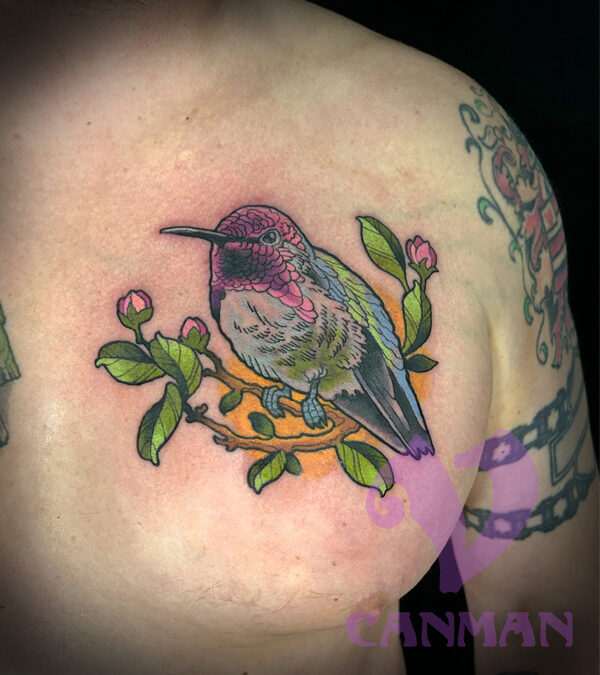Hummingbird tattoos are a quite popular choice for bird fans.
This memorial tattoo represents the clients mother’s love for hummingbirds.
In addition, the 3 flower buds represent his mother’s 3 sisters.
Do you like hummingbird tattoos and want your own custom version?
We got your back jack!
Go to our Tattoo Request Form to get your tattoo project started!
About hummingbirds
Hummingbirds are fascinating and unique creatures known for their vibrant colors, rapid wing flapping, and remarkable flying abilities.
Hummingbirds are among the smallest birds in the world.
Most species measuring between 3 to 5 inches in length and weighing less than 0.2 ounces.
Their iridescent feathers can appear to change color depending on the light.
This feature particularly prominent in males, which they use to attract mates.
They can flap their wings up to 80 times per second.
This allows them to hover in place and even fly backwards.
Hummingbirds are capable of flying at speeds of up to 34 miles per hour.
Their agility is unmatched, allowing them to perform intricate aerial maneuvers.
Hummingbirds have an extremely high metabolism, consuming up to twice their body weight in nectar daily.
They primarily feed on nectar from flowers, which provides the necessary sugar for their energy needs.
They also eat insects and spiders for protein.
Hummingbirds are native to the Americas, with the greatest diversity found in South America, particularly in the Andes. They can be found from Alaska to Tierra del Fuego.
Some species, like the Ruby-throated Hummingbird, migrate long distances.
For example, they travel from Central America to North America during the breeding season.
Female hummingbirds build tiny, cup-shaped nests using spider silk, plant down, and other materials.
They lay 1-3 eggs per clutch.
In the wild, hummingbirds typically live 3 to 5 years, though some can live up to a decade under optimal conditions.
Hummingbirds face threats from habitat loss, climate change, and predation by larger birds, cats, and other animals.
Conservation efforts include preserving natural habitats and providing feeders in areas where natural food sources are scarce.
Their hearts can beat up to 1,260 times per minute, especially when hovering.
Hummingbirds enter a state of torpor at night, significantly slowing their metabolism to conserve energy.
Hummingbirds are not only critical pollinators in many ecosystems but also a source of wonder due to their extraordinary flying abilities and beautiful appearance.
Their presence is a vital indicator of the health of their habitats.
